The Technical Challenges Facing the Integration of Small-Scale and Large-scale PV Systems into the Grid: A Critical Review
Abstract
1. Introduction
2. The Distinct Characteristics of Renewable Energy Generation That Impacts the Grid System
2.1. Partial Unpredictability
2.2. Non-Controllable Variability
- Voltage suppor uses the reactive power of the generators to raise the voltage whenever it is necessary.
- Frequency regulation is performed through signals to the generators from the automatic generation control (AGC) on the basis of seconds to minutes [24].
- Spinning and non-spinning reserves use the generator’s available power to act as a generation reserve whenever the system goes down. If the generator provides the power within a couple of few minutes it is classified as spinning and if it takes a longer time it is classified as non-spinning.
- Black-start capacity is the generator’s ability to start the system in the case of a black-out.
2.3. Location Dependent
3. Technical Challenges of Integrating High Penetration Levels of Small-Scale PV Systems into the Grid
3.1. Voltage Regulation
3.2. Power Quality
3.3. Harmonics Distortion
3.4. Protection Challenges
3.5. Technical Solutions
- Area based on load tap changer (OLTC) coordinated voltage control
- Generation curtailment during low demand
- Consumption shifting and curtailing
- Energy storage system with coordination
- Reactive power control
4. Technical Challenges of Integrating Large-Scale PV Systems into the Grid
- Fault-ride through requirements
- Active power and frequency control
- Reactive power and voltage control
- Voltage and frequency boundaries
4.1. Localised Technical Challenges of the PV Plant
4.1.1. Active Power Regulation
4.1.2. Reactive Power Regulation
4.1.3. Power Quality
4.2. Grid System Stability Challenges
- Voltage stability is the ability of the power system to sustain the acceptable voltage levels across all the buses of the system during normal operating conditions and after being subjected to a disturbance. Instability of the voltage levels may occur as a result of an uncontrollable and progressive rise or fall in voltage levels of some buses in the system.
- Rotor angle stability is the ability of the traditional synchronised generators in the grid power system to maintain that synchronism after being subjected to a disturbance. To have a better understanding of rotor angle stability, it is useful to separate it into small disturbance rotor angle stability, better known small signal stability, and large disturbance rotor angle stability, better known as transient stability.
- Frequency stability is the ability of the power system to maintain or restore the balance between the generation and load after being subjected to a disturbance, which is done by maintaining the frequency within its applicable limit. The disturbance causes a significant mismatch between generation and load.
4.2.1. Voltage Stability
- Large disturbance voltage stability is when the power system must uphold constant voltages after being ejected with a severe disturbance such as a loss of large generator. The voltage stability phenomenon can be either long term or short term. Therefore, the time frame of this kind of study may vary from a few seconds to minutes to capture the performance of the power system equipment [73].
- Small disturbance voltage stability is when the power system must uphold constant voltages after being ejected with a small disturbance such as the changes in the load of the system. Small disturbance voltage stability can be investigated via linearising the power system equations considering the appropriate computation assumptions. However, it is better to keep in mind that, with the linearised method, non-linear effects such as time delays and tap changer controls are not considered [75]. The time frame to conduct this study is similar to the large disturbance voltage stability time frame.
4.2.2. Rotor Angle Stability
- Large disturbance rotor angle stability, better known as transient stability, is when the power system must remain synchronised after being ejected with a severe disturbance such as transmission line short circuit. The transient stability depends on both the original operating state of the system and the severity of the disturbance.
- Small disturbance rotor angle stability, better known as small signal stability, is when the power system must remain synchronised after being ejected with small disturbance such as the changes in the load of the system. The small signal stability depends on the strength of the system, the original operating state of the system and the type of generator excitation controls used.
4.2.3. Frequency Stability
4.3. Technical Solutions
- Upgrading the grid is done to strengthen and improve the grid via processes such as expansion and integration. However, grid upgrade can be considered a costly option among other aspects.
- Improving the forecasting of renewable energy successfully eliminates the uncertainty aspect of renewable energy but not its output variability.
- Increasing back-up power is done through using the traditional dispatchable power. However, this method emits large quantities of greenhouse gas (GHS) because it is hydrocarbon-based.
- Demand side management (DSM) reduces its potential for viability due to the consumer’s behavioural aspects in decision making [89].
- Integration of energy storage technologies is a very promising method because it can offer time-shifting ability, decouple the supply and demand, reduce curtailment, relieve the grid’s congestion and regulate the grid by smoothing the fluctuations of the frequency and voltage to ensure both security and reliability of the grid [90].
5. The Current Practices for Managing the Variability of Large-Scale PV Systems by the Grid Operators
5.1. Germany
- The existing strength of the grid implies that outages rarely occur and it possesses more capacity than required for the given current demand. However, Germany has needed to increase the strength of its transmission lines with planning to increase its capacity further to accommodate more renewable energy [102].
- The operational flexibility of the conventional power plants means there is a surplus of conventional power capacity that is being utilised effectively to provide the required balancing power to offset the variability that comes with renewable generation. Most of the conventional power plants were originally designed or later modified to provide a flexible output by being able to ramp on an hourly basis to a value much lower than the highest output and being able daily to cycle on and off [103]. In addition, these conventional power plants can sell their power into the ancillary electricity market to provide minute-by-minute and hour-by-hour balancing in order to eliminate any mismatch between the supply and demand [99]. However, these conventional power plants are not selling much of their power on the day-ahead wholesale market because of solar and wind energy receiving priority of dispatch in the mentioned market [104].
- The improved design of the ancillary power markets implies that both the balancing and intraday electricity market have been modified to provide greater flexibility to accommodate renewables.
- The improved system control software and day-ahead weather forecasting means that the grid operators have greatly improved their software to accommodate higher ramp rates, evolving the system’s reliability calculations to consider renewables. In addition, improving the day ahead weather forecasting is a vital part of improving the balancing of renewable energy in the grid.
- The technical adjustments to the local-level distribution system is executed to cope with the reverse power flow effect due to the presence of the renewable in the distribution level.
- The ability to export power to the neighbouring countries: The high levels of renewable energy generation on peak days causes the prices of the electricity market to drop to zero or even be negative, which leads to the effect of reducing the output of the conventional power plants and exporting power to neighbouring countries. However, the approach of importing and exporting power from the neighbouring countries has a very modest part in balancing renewables because of the regulation of the markets in the form of prohibiting importing power in Germany for example and the bidding time frame is too long for importing or exporting power for renewable energy balancing purposes [101]. The electricity exported from Germany throughout the recent years are shown in Figure 12 [100].
- Solving the 50.2 Hz inverter issue implies that the inverters cut-off frequency has been modified to vary rather than having it all the same to avoid a massive threat on the grid’s stability as it has much solar energy.
5.2. California (USA)
5.2.1. California ISO Using Utility-Scale PV Systems to Provide Ancillary Services
5.2.2. California ISO Dealing with a Solar Eclipse
- The adjustable-rapid power plants such as gas-fired and hydroelectric ones
- The regional power market that is built purposely to balance the quick shifting of renewable energy
- The growing capability of storing electricity via energy storage
- The capability of shaping the demand of power in real time via demand response
6. Discussion and Way Forwards
- By installing large-scale energy storage to balance the surplus and shortage of renewable energy generation and hence stabilise the grid
- By increasing transmission flexibility to enable accessing large shares of resources in order to aid balancing both local and regional deficits or excesses
7. Conclusions
Author Contributions
Funding
Conflicts of Interest
References
- Bilgili, M.; Ozbek, A.; Sahin, B.; Kahraman, A. An overview of renewable electric power capacity and progress in new technologies in the world. Renew. Sustain. Energy Rev. 2015, 49, 323–334. [Google Scholar] [CrossRef]
- Manzano-Agugliaro, F.; Alcayde, A.; Montoya, F.G.; Zapata-Sierra, A.; Gil, C. Scientific production of renewable energies worldwide: An overview. Renew. Sustain. Energy Rev. 2013, 18, 134–143. [Google Scholar] [CrossRef]
- Markvart, T. Solar Electricity; John Wiley & Sons: Chichester, UK, 2000; Volume 6. [Google Scholar]
- Ackermann, T.; Andersson, G.; Söder, L. Distributed generation: A definition. Electr. Power Syst. Res. 2001, 57, 195–204. [Google Scholar] [CrossRef]
- Zhang, H.L.; Baeyens, J.; Degrève, J.; Cacères, G. Concentrated solar power plants: Review and design methodology. Renew. Sustain. Energy Rev. 2013, 22, 466–481. [Google Scholar] [CrossRef]
- Li, Q.; Wolfs, P. A Review of the Single Phase Photovoltaic Module Integrated Converter Topologies with Three Different DC Link Configurations. IEEE Trans. Power Electron. 2008, 23, 1320–1333. [Google Scholar] [CrossRef]
- Branker, K.; Pathak, M.J.M.; Pearce, J.M. A review of solar photovoltaic levelized cost of electricity. Renew. Sustain. Energy Rev. 2011, 15, 4470–4482. [Google Scholar] [CrossRef]
- Zubo, R.H.A.; Mokryani, G.; Rajamani, H.-S.; Aghaei, J.; Niknam, T.; Pillai, P. Operation and planning of distribution networks with integration of renewable distributed generators considering uncertainties: A review. Renew. Sustain. Energy Rev. 2017, 72, 1177–1198. [Google Scholar] [CrossRef]
- Karimi, M.; Mokhlis, H.; Naidu, K.; Uddin, S.; Bakar, A.H.A. Photovoltaic penetration issues and impacts in distribution network–A review. Renew. Sustain. Energy Rev. 2016, 53, 594–605. [Google Scholar] [CrossRef]
- Haque, M.M.; Wolfs, P. A review of high PV penetrations in LV distribution networks: Present status, impacts and mitigation measures. Renew. Sustain. Energy Rev. 2016, 62, 1195–1208. [Google Scholar] [CrossRef]
- Kannan, N.; Vakeesan, D. Solar energy for future world: - A review. Renew. Sustain. Energy Rev. 2016, 62, 1092–1105. [Google Scholar] [CrossRef]
- Shafiullah, G.M.; Oo, A.M.T.; Shawkat Ali, A.B.M.; Wolfs, P. Potential challenges of integrating large-scale wind energy into the power grid—A review. Renew. Sustain. Energy Rev. 2013, 20, 306–321. [Google Scholar] [CrossRef]
- Infield, D. Chapter 15—Wind Energy A2—Letcher. In Future Energy, 2nd ed.; Trevor, M., Ed.; Elsevier: Boston, MA, USA, 2014; pp. 313–333. [Google Scholar]
- EIA. Cost and Performance Characteristics of New Generating Technologies, Annual Energy Outlook; U.S. Energy Information Administration (EIA): Washington, DC, USA, 2019.
- Cabrera-Tobar, A.; Bullich-Massagué, E.; Aragüés-Peñalba, M.; Gomis-Bellmunt, O. Review of advanced grid requirements for the integration of large scale photovoltaic power plants in the transmission system. Renew. Sustain. Energy Rev. 2016, 62, 971–987. [Google Scholar] [CrossRef]
- Shah, R.; Mithulananthan, N.; Bansal, R.C.; Ramachandaramurthy, V.K. A review of key power system stability challenges for large-scale PV integration. Renew. Sustain. Energy Rev. 2015, 41, 1423–1436. [Google Scholar] [CrossRef]
- Ding, M.; Xu, Z.; Wang, W.; Wang, X.; Song, Y.; Chen, D. A review on China’s large-scale PV integration: Progress, challenges and recommendations. Renew. Sustain. Energy Rev. 2016, 53, 639–652. [Google Scholar] [CrossRef]
- Nghitevelekwa, K.; Bansal, R.C. A review of generation dispatch with large-scale photovoltaic systems. Renew. Sustain. Energy Rev. 2018, 81, 615–624. [Google Scholar] [CrossRef]
- Zheng, Q.P.; Wang, J.; Liu, A.L. Stochastic Optimization for Unit Commitment—A Review. IEEE Trans. Power Syst. 2015, 30, 1913–1924. [Google Scholar] [CrossRef]
- Li, Z.; Jin, T.; Zhao, S.; Liu, J. Power System Day-Ahead Unit Commitment Based on Chance-Constrained Dependent Chance Goal Programming. Energies 2018, 11, 1718. [Google Scholar] [CrossRef]
- Marneris, G.I.; Biskas, N.P.; Bakirtzis, G.A. Stochastic and Deterministic Unit Commitment Considering Uncertainty and Variability Reserves for High Renewable Integration. Energies 2017, 10, 140. [Google Scholar] [CrossRef]
- Wang, J.; Botterud, A.; Bessa, R.; Keko, H.; Carvalho, L.; Issicaba, D.; Sumaili, J.; Miranda, V. Wind power forecasting uncertainty and unit commitment. Appl. Energy 2011, 88, 4014–4023. [Google Scholar] [CrossRef]
- Zaheeruddin; Manas, M. Renewable energy management through microgrid central controller design: An approach to integrate solar, wind and biomass with battery. Energy Rep. 2015, 1, 156–163. [Google Scholar] [CrossRef]
- Liu, Q.; Ilić, M.D. Enhanced Automatic Generation Control (E-AGC) for future electric energy systems. In Proceedings of the 2012 IEEE Power and Energy Society General Meeting, San Diego, CA, USA, 22–26 July 2012; pp. 1–8. [Google Scholar]
- Basso, T.S.; DeBlasio, R. IEEE 1547 series of standards: Interconnection issues. IEEE Trans. Power Electron. 2004, 19, 1159–1162. [Google Scholar] [CrossRef]
- Sreedharan, P.; Farbes, J.; Cutter, E.; Woo, C.K.; Wang, J. Microgrid and renewable generation integration: University of California, San Diego. Appl. Energy 2016, 169, 709–720. [Google Scholar] [CrossRef]
- Eltawil, M.A.; Zhao, Z. Grid-connected photovoltaic power systems: Technical and potential problems—A review. Renew. Sustain. Energy Rev. 2010, 14, 112–129. [Google Scholar] [CrossRef]
- Mirhassani, S.; Ong, H.C.; Chong, W.T.; Leong, K.Y. Advances and challenges in grid tied photovoltaic systems. Renew. Sustain. Energy Rev. 2015, 49, 121–131. [Google Scholar] [CrossRef]
- Shivashankar, S.; Mekhilef, S.; Mokhlis, H.; Karimi, M. Mitigating methods of power fluctuation of photovoltaic (PV) sources—A review. Renew. Sustain. Energy Rev. 2016, 59, 1170–1184. [Google Scholar] [CrossRef]
- Ali, M.S.; Haque, M.M.; Wolfs, P. A review of topological ordering based voltage rise mitigation methods for LV distribution networks with high levels of photovoltaic penetration. Renew. Sustain. Energy Rev. 2019, 103, 463–476. [Google Scholar] [CrossRef]
- Razavi, S.-E.; Rahimi, E.; Javadi, M.S.; Nezhad, A.E.; Lotfi, M.; Shafie-khah, M.; Catalão, J.P.S. Impact of distributed generation on protection and voltage regulation of distribution systems: A review. Renew. Sustain. Energy Rev. 2019, 105, 157–167. [Google Scholar] [CrossRef]
- Pillai, D.S.; Rajasekar, N. A comprehensive review on protection challenges and fault diagnosis in PV systems. Renew. Sustain. Energy Rev. 2018, 91, 18–40. [Google Scholar] [CrossRef]
- Chaudhary, P.; Rizwan, M. Voltage regulation mitigation techniques in distribution system with high PV penetration: A review. Renew. Sustain. Energy Rev. 2018, 82, 3279–3287. [Google Scholar] [CrossRef]
- El-Amin, I.M.; Ali, M.S. Impact of PV system on distribution networks. In Proceedings of the 2011 IEEE PES Conference on Innovative Smart Grid Technologies—Middle East, Jeddah, Saudi Arabia, 17–20 December 2011; pp. 1–6. [Google Scholar]
- IEEE. 1100-1992 Recommended Practice for Powering and Grounding Sensitive Electronic Equipment; IEEE: Toulouse, France, 1992; pp. 1–256. [Google Scholar] [CrossRef]
- Walling, R.A.; Saint, R.; Dugan, R.C.; Burke, J.; Kojovic, L.A. Summary of Distributed Resources Impact on Power Delivery Systems. IEEE Trans. Power Deliv. 2008, 23, 1636–1644. [Google Scholar] [CrossRef]
- Latheef, A.; Robinson, D.; Gosbell, V.J.; Smith, V.W. Harmonic impact of photovoltaic inverters on low voltage distribution systems. In Proceedings of the 2006 Australasian Universities Power Engineering Conference (AUPEC’06), Melbourne, Australia, 4–6 December 2006. [Google Scholar]
- Lewis, S.J. Analysis and management of the impacts of a high penetration of photovoltaic systems in an electricity distribution network. In Proceedings of the 2011 IEEE PES Innovative Smart Grid Technologies, Perth, Australia, 13–16 November 2011; pp. 1–7. [Google Scholar]
- Girgis, A.; Brahma, S. Effect of distributed generation on protective device coordination in distribution system. In Proceedings of the LESCOPE 01. 2001 Large Engineering Systems Conference on Power Engineering. Conference Proceedings, Halifax, NS, Canada, 11–13 July 2001; pp. 115–119. [Google Scholar]
- Lopes, J.A.P.; Hatziargyriou, N.; Mutale, J.; Djapic, P.; Jenkins, N. Integrating distributed generation into electric power systems: A review of drivers, challenges and opportunities. Electr. Power Syst. Res. 2007, 77, 1189–1203. [Google Scholar] [CrossRef]
- Ropp, M.E.; Begovic, M.; Rohatgi, A.; Kern, G.A.; Bonn, R.H.; Gonzalez, S. Determining the relative effectiveness of islanding detection methods using phase criteria and nondetection zones. IEEE Trans. Energy Convers. 2000, 15, 290–296. [Google Scholar] [CrossRef]
- Mahmud, N.; Zahedi, A. Review of control strategies for voltage regulation of the smart distribution network with high penetration of renewable distributed generation. Renew. Sustain. Energy Rev. 2016, 64, 582–595. [Google Scholar] [CrossRef]
- Mehmood, K.K.; Khan, S.U.; Lee, S.-J.; Haider, Z.M.; Rafique, M.K.; Kim, C.-H. A real-time optimal coordination scheme for the voltage regulation of a distribution network including an OLTC, capacitor banks, and multiple distributed energy resources. Int. J. Electr. Power Energy Syst. 2018, 94, 1–14. [Google Scholar] [CrossRef]
- Azzouz, M.A.; Farag, H.E.; El-Saadany, E.F. Real-Time Fuzzy Voltage Regulation for Distribution Networks Incorporating High Penetration of Renewable Sources. IEEE Syst. J. 2017, 11, 1702–1711. [Google Scholar] [CrossRef]
- Shalwala, R.A.; Bleijs, J.A.M. Voltage control scheme using Fuzzy Logic for residential area networks with PV generators in Saudi Arabia. In Proceedings of the ISGT 2011, Manchester, UK, 17–19 January 2011; pp. 1–6. [Google Scholar]
- Capitanescu, F.; Bilibin, I.; Ramos, E.R. A Comprehensive Centralized Approach for Voltage Constraints Management in Active Distribution Grid. IEEE Trans. Power Syst. 2014, 29, 933–942. [Google Scholar] [CrossRef]
- Alyami, S.; Wang, Y.; Wang, C.; Zhao, J.; Zhao, B. Adaptive Real Power Capping Method for Fair Overvoltage Regulation of Distribution Networks with High Penetration of PV Systems. IEEE Trans. Smart Grid 2014, 5, 2729–2738. [Google Scholar] [CrossRef]
- Tonkoski, R.; Lopes, L.A.C.; El-Fouly, T.H.M. Coordinated Active Power Curtailment of Grid Connected PV Inverters for Overvoltage Prevention. IEEE Trans. Sustain. Energy 2011, 2, 139–147. [Google Scholar] [CrossRef]
- Faria, P.; Vale, Z.; Baptista, J. Constrained consumption shifting management in the distributed energy resources scheduling considering demand response. Energy Convers. Manag. 2015, 93, 309–320. [Google Scholar] [CrossRef]
- Wang, L.; Li, Q.; Ding, R.; Sun, M.; Wang, G. Integrated scheduling of energy supply and demand in microgrids under uncertainty: A robust multi-objective optimization approach. Energy 2017, 130, 1–14. [Google Scholar] [CrossRef]
- Wang, Y.; Tan, K.T.; Peng, X.Y.; So, P.L. Coordinated Control of Distributed Energy-Storage Systems for Voltage Regulation in Distribution Networks. IEEE Trans. Power Deliv. 2016, 31, 1132–1141. [Google Scholar] [CrossRef]
- Kabir, M.N.; Mishra, Y.; Ledwich, G.; Dong, Z.Y.; Wong, K.P. Coordinated Control of Grid-Connected Photovoltaic Reactive Power and Battery Energy Storage Systems to Improve the Voltage Profile of a Residential Distribution Feeder. IEEE Trans. Ind. Inform. 2014, 10, 967–977. [Google Scholar] [CrossRef]
- Ho, W.S.; Macchietto, S.; Lim, J.S.; Hashim, H.; Muis, Z.A.; Liu, W.H. Optimal scheduling of energy storage for renewable energy distributed energy generation system. Renew. Sustain. Energy Rev. 2016, 58, 1100–1107. [Google Scholar] [CrossRef]
- Ranaweera, I.; Midtgård, O.-M.; Korpås, M. Distributed control scheme for residential battery energy storage units coupled with PV systems. Renew. Energy 2017, 113, 1099–1110. [Google Scholar] [CrossRef]
- Demirok, E.; González, P.C.; Frederiksen, K.H.B.; Sera, D.; Rodriguez, P.; Teodorescu, R. Local Reactive Power Control Methods for Overvoltage Prevention of Distributed Solar Inverters in Low-Voltage Grids. IEEE J. Photovolt. 2011, 1, 174–182. [Google Scholar] [CrossRef]
- Mohseni, M.; Islam, S.M. Review of international grid codes for wind power integration: Diversity, technology and a case for global standard. Renew. Sustain. Energy Rev. 2012, 16, 3876–3890. [Google Scholar] [CrossRef]
- Obi, M.; Bass, R. Trends and challenges of grid-connected photovoltaic systems—A review. Renew. Sustain. Energy Rev. 2016, 58, 1082–1094. [Google Scholar] [CrossRef]
- Tsili, M.; Papathanassiou, S. A review of grid code technical requirements for wind farms. IET Renew. Power Gener. 2009, 3, 308–332. [Google Scholar] [CrossRef]
- Top 50 Large-Scale Photovoltaic Power Plants. Available online: http://www.pvresources.com/en/top50pv.php (accessed on 15 March 2019).
- Cabrera-Tobar, A.; Bullich-Massagué, E.; Aragüés-Peñalba, M.; Gomis-Bellmunt, O. Topologies for large scale photovoltaic power plants. Renew. Sustain. Energy Rev. 2016, 59, 309–319. [Google Scholar] [CrossRef]
- Anzalchi, A.; Sarwat, A. Overview of technical specifications for grid-connected photovoltaic systems. Energy Convers. Manag. 2017, 152, 312–327. [Google Scholar] [CrossRef]
- Bhatnagar, P.; Nema, R.K. Maximum power point tracking control techniques: State-of-the-art in photovoltaic applications. Renew. Sustain. Energy Rev. 2013, 23, 224–241. [Google Scholar] [CrossRef]
- Saravanan, S.; Ramesh Babu, N. Maximum power point tracking algorithms for photovoltaic system—A review. Renew. Sustain. Energy Rev. 2016, 57, 192–204. [Google Scholar] [CrossRef]
- Ellis, A.; Nelson, R.; Engeln, E.V.; Walling, R.; MacDowell, J.; Casey, L.; Seymour, E.; Peter, W.; Barker, C.; Kirby, B.; et al. Reactive power performance requirements for wind and solar plants. In Proceedings of the 2012 IEEE Power and Energy Society General Meeting, San Diego, CA, USA, 22–26 July 2012; pp. 1–8. [Google Scholar]
- Pathak, A.K.; Sharma, M.P.; Bundele, M. A critical review of voltage and reactive power management of wind farms. Renew. Sustain. Energy Rev. 2015, 51, 460–471. [Google Scholar] [CrossRef]
- Lund, T.; Sorensen, P.; Eek, J. Reactive Power Capability of a Wind Turbine with Doubly Fed Induction Generator. Wind Energy 2007, 10, 379–394. [Google Scholar] [CrossRef]
- Aly, M.M.; Abdel-Akher, M.; Ziadi, Z.; Senjyu, T. Assessment of reactive power contribution of photovoltaic energy systems on voltage profile and stability of distribution systems. Int. J. Electr. Power Energy Syst. 2014, 61, 665–672. [Google Scholar] [CrossRef]
- Varma, R.K.; Salama, M. Large-scale photovoltaic solar power integration in transmission and distribution networks. In Proceedings of the 2011 IEEE Power and Energy Society General Meeting, Detroit, MI, USA, 24–29 July 2011; pp. 1–4. [Google Scholar]
- Zheng, C.; Zhou, L.; Guo, K.; Liu, Q.; Xie, B. Stability study of large-scale photovoltaic plant containing polytype inverters. In Proceedings of the 2016 IEEE International Power Electronics and Motion Control Conference (PEMC), Varna, Bulgaria, 25–28 September 2016; pp. 470–475. [Google Scholar]
- Kundur, P.; Paserba, J.; Ajjarapu, V.; Andersson, G.; Bose, A.; Canizares, C.; Hatziargyriou, N.; Hill, D.; Stankovic, A.; Taylor, C.; et al. Definition and classification of power system stability IEEE/CIGRE joint task force on stability terms and definitions. IEEE Trans. Power Syst. 2004, 19, 1387–1401. [Google Scholar] [CrossRef]
- Machowski, J. Power System Dynamics [Electronic Resource]: Stability and Control, 2nd ed.; Machowski, J., Janusz, W., Bialek, J., Bumby, R., Eds.; Wiley: Chichester, UK, 2008. [Google Scholar]
- Pavella, M.; Ernst, D.; Ruiz-Vega, D. Transient Stability of Power Systems: A Unified Approach to Assessment and Control; Pavella, M., Ernst, D., Ruiz-Vega, D., Eds.; Springer Science and Business Media: New York, NY, USA, 2000. [Google Scholar]
- Kundur, P. Power System Stability and Control; Kundur, P., Balu, N.J., Lauby, M.G., Eds.; McGraw-Hill: New York, NY, USA, 1994. [Google Scholar]
- Taylor, C.W.; Balu, N.J.; Maratukulam, D. Power System Voltage Stability; McGraw-Hill: New York, NY, USA, 1994. [Google Scholar]
- Morison, G.K.; Gao, B.; Kundur, P. Voltage stability analysis using static and dynamic approaches. IEEE Trans. Power Syst. 1993, 8, 1159–1171. [Google Scholar] [CrossRef]
- Eftekharnejad, S.; Vittal, V.; Heydt, G.T.; Keel, B.; Loehr, J. Impact of increased penetration of photovoltaic generation on power systems. IEEE Trans. Power Syst. 2013, 28, 893–901. [Google Scholar] [CrossRef]
- Tamimi, B.; Cañizares, C.; Bhattacharya, K. System Stability Impact of Large-Scale and Distributed Solar Photovoltaic Generation: The Case of Ontario, Canada. IEEE Trans. Sustain. Energy 2013, 4, 680–688. [Google Scholar] [CrossRef]
- Omran, W.A.; Kazerani, M.; Salama, M.M.A. A Clustering-Based Method for Quantifying the Effects of Large On-Grid PV Systems. IEEE Trans. Power Deliv. 2010, 25, 2617–2625. [Google Scholar] [CrossRef]
- Kabir, S.; Nadarajah, M.; Bansal, R. Impact of large scale photovoltaic system on static voltage stability in sub-transmission network. In Proceedings of the 2013 IEEE ECCE Asia Downunder, Melbourne, Australia, 3–6 June 2013; pp. 468–473. [Google Scholar]
- Nguyen Hoang, V.; Yokoyama, A. Impact of fault ride-through characteristics of high-penetration photovoltaic generation on transient stability. In Proceedings of the 2010 International Conference on Power System Technology, Hangzhou, China, 24–28 October 2010; pp. 1–7. [Google Scholar]
- Eto, J.H. Use of Frequency Response Metrics to Assess the Planning and Operating Requirements for Reliable Integration of Variable Renewable Generation; Lawrence Berkeley National Lab. (LBNL): Berkeley, CA, USA, 2011. [Google Scholar]
- Tielens, P.; Van Hertem, D. The relevance of inertia in power systems. Renew. Sustain. Energy Rev. 2016, 55, 999–1009. [Google Scholar] [CrossRef]
- Seneviratne, C.; Ozansoy, C. Frequency response due to a large generator loss with the increasing penetration of wind/PV generation–A literature review. Renew. Sustain. Energy Rev. 2016, 57, 659–668. [Google Scholar] [CrossRef]
- Abdlrahem, A.; Venayagamoorthy, G.K.; Corzine, K.A. Frequency stability and control of a power system with large PV plants using PMU information. In Proceedings of the 2013 North American Power Symposium (NAPS), Manhattan, KS, USA, 22–24 September 2013; pp. 1–6. [Google Scholar]
- Rahmann, C.; Castillo, A. Fast Frequency Response Capability of Photovoltaic Power Plants: The Necessity of New Grid Requirements and Definitions. Energies 2014, 7, 6306–6322. [Google Scholar] [CrossRef]
- Weckmann, S.; Kuhlmann, T.; Sauer, A. Decentral Energy Control in a Flexible Production to Balance Energy Supply and Demand. Procedia Cirp 2017, 61, 428–433. [Google Scholar] [CrossRef]
- Grunewald, P. Flexibility in supply and demand. In Proceedings of the DEMAND Centre Conference, Lancaster, UK, 13–15 April 2016; pp. 13–15. [Google Scholar]
- Kondziella, H.; Bruckner, T. Flexibility requirements of renewable energy based electricity systems—A review of research results and methodologies. Renew. Sustain. Energy Rev. 2016, 53, 10–22. [Google Scholar] [CrossRef]
- Kim, J.-H.; Shcherbakova, A. Common failures of demand response. Energy 2011, 36, 873–880. [Google Scholar] [CrossRef]
- Denholm, P.; Hand, M. Grid flexibility and storage required to achieve very high penetration of variable renewable electricity. Energy Policy 2011, 39, 1817–1830. [Google Scholar] [CrossRef]
- Guney, M.S.; Tepe, Y. Classification and assessment of energy storage systems. Renew. Sustain. Energy Rev. 2017, 75, 1187–1197. [Google Scholar] [CrossRef]
- Parra, D.; Swierczynski, M.; Stroe, D.I.; Norman, S.A.; Abdon, A.; Worlitschek, J.; O’Doherty, T.; Rodrigues, L.; Gillott, M.; Zhang, X.; et al. An interdisciplinary review of energy storage for communities: Challenges and perspectives. Renew. Sustain. Energy Rev. 2017, 79, 730–749. [Google Scholar] [CrossRef]
- Saboori, H.; Hemmati, R.; Ghiasi, S.M.S.; Dehghan, S. Energy storage planning in electric power distribution networks–A state-of-the-art review. Renew. Sustain. Energy Rev. 2017, 79, 1108–1121. [Google Scholar] [CrossRef]
- Møller, K.T.; Jensen, T.R.; Akiba, E.; Li, H.-W. Hydrogen—A sustainable energy carrier. Prog. Nat. Sci. Mater. Int. 2017, 27, 34–40. [Google Scholar] [CrossRef]
- Bade, G. Utility-Scale Solar Integration—What You Need to Know; Utility Dive: Washington, DC, USA, 2017. [Google Scholar]
- Denny, E.; O’Malley, M. The impact of carbon prices on generation-cycling costs. Energy Policy 2009, 37, 1204–1212. [Google Scholar] [CrossRef]
- Renn, O.; Marshall, J.P. Coal, nuclear and renewable energy policies in Germany: From the 1950s to the “Energiewende”. Energy Policy 2016, 99, 224–232. [Google Scholar] [CrossRef]
- Martin, R. Germany runs up against the limits of renewables. Technol. Rev. 2016. Available online: https://www.technologyreview.com/ (accessed on 13 September 2019).
- Strunz, S. The German energy transition as a regime shift. Ecol. Econ. 2014, 100, 150–158. [Google Scholar] [CrossRef]
- Wirth, H. Recent Facts about Photovoltaics in Germany; Fraunhofer ISE: Freiburg, Germany, 2018. [Google Scholar]
- Martinot, E. Grid integration of renewables in China: Learning from the cases of California, Germany, and Denmark. Cent. Energy Environ. Policy 2015. Available online: http://www.martinot.info/index.htm (accessed on 13 September 2019).
- Ball, J. Germany’s High-Priced Energy Revolution. Fortune 2017, 14. Available online: https://fortune.com/ (accessed on 13 September 2019).
- Cochran, J.; Lew, D.; Kumar, N. Flexible Coal: Evolution from Baseload to Peaking Plant. (Brochure); National Renewable Energy Laboratory (NREL): Golden, CO, USA, 2013. [Google Scholar]
- Paraschiv, F.; Erni, D.; Pietsch, R. The impact of renewable energies on EEX day-ahead electricity prices. Energy Policy 2014, 73, 196–210. [Google Scholar] [CrossRef]
- Morris, C. Germany has surpassed its 2020 target for green power. Energy Transit. Glob. Energ. 2017. Available online: https://energytransition.org/ (accessed on 13 September 2019).
- Hill, J. California to Meet 2030 Renewable Energy Targets by 2020; CleanTechnica: Reno, NV, USA, 2017. [Google Scholar]
- Renewables and Reliability: Grid Management Solutions to Support California’s Clean Energy Future; Union of Concerned Scientists: Cambridge, MA, USA, 2015.
- Kristov, L.; Hou, D. Chapter 18—Rethinking the Transmission-Distribution Interface in a Distributed Energy Future. In Distributed Generation and Its Implications for the Utility Industry; Sioshansi, F.P., Ed.; Academic Press: Boston, MA, USA, 2014; pp. 359–377. [Google Scholar]
- Trabish, H. California Solar Pilot Shows How Renewables Can. Provide Grid Services; Utility Dive: Washington, DC, USA, 2017. [Google Scholar]
- Walton, R. After Aliso Canyon Methane Leak, California natural Gas. Generation down 20%; Utility Dive: Washington, DC, USA, 2016. [Google Scholar]
- Murtaugh, G. Annual Report on Market. Issues & Performance; California ISO: Folsom, CA, USA, 2015. [Google Scholar]
- Schleuss, J. A Solar Eclipse is Coming on August 21. Here’s What It Will Look Like Where You Are; Los Angeles Times: Los Angeles, CA, USA, 2017. [Google Scholar]
- Niiler, E. How Will California’s Solar Grid React. to the Eclipse? Wired Magazine: London, UK, 2017. [Google Scholar]
- Fairley, P. How California Grid Operators Managed the Eclipse. IEEE Spectrum 2017. Available online: https://spectrum.ieee.org/ (accessed on 13 September 2019).
- Fairley, P. European Grid Operators 1, Solar Eclipse 0. IEEE Spectrum 2015. Available online: https://spectrum.ieee.org/ (accessed on 13 September 2019).
- Ackermann, T.; Carlini, E.M.; Ernst, B.; Groome, F.; Orths, A.; Sullivan, J.O.; Rodriguez, M.d.l.T.; Silva, V. Integrating Variable Renewables in Europe: Current Status and Recent Extreme Events. IEEE Power Energy Mag. 2015, 13, 67–77. [Google Scholar] [CrossRef]
- Wells, J. What does the solar eclipse mean for solar power? Duke Energy 2017. Available online: https://illumination.duke-energy.com/ (accessed on 13 September 2019).
- Crabtree, G.; Misewich, J.; Ambrosio, R.; Clay, K.; DeMartini, P.; James, R.; Lauby, M.; Mohta, V.; Moura, J.; Sauer, P. Integrating renewable electricity on the grid. In Proceedings of the AIP Conference Proceedings, Geneva, Switzerland, 15–20 September 2017; pp. 387–405. [Google Scholar]
- Jones, J. Balancing Act: How Can We Deal with Variability? Renew. Energy 2011. Available online: https://www.renewableenergyworld.com/ (accessed on 13 September 2019).
- Cochran, J.; Miller, M.; Zinaman, O.; Milligan, M.; Arent, D.; Palmintier, B.; O’Malley, M.; Mueller, S.; Lannoye, E.; Tuohy, A. Flexibility in 21st Century Power Systems; National Renewable Energy Lab. (NREL): Golden, CO, USA, 2014. [Google Scholar]
- Golden, R.; Paulos, B. Curtailment of Renewable Energy in California and Beyond. Electr. J. 2015, 28, 36–50. [Google Scholar] [CrossRef]
- Haegel, N.M.; Margolis, R.; Buonassisi, T.; Feldman, D.; Froitzheim, A.; Garabedian, R.; Green, M.; Glunz, S.; Henning, H.-M.; Holder, B.; et al. Terawatt-scale photovoltaics: Trajectories and challenges. Science 2017, 356, 141. [Google Scholar] [CrossRef] [PubMed]
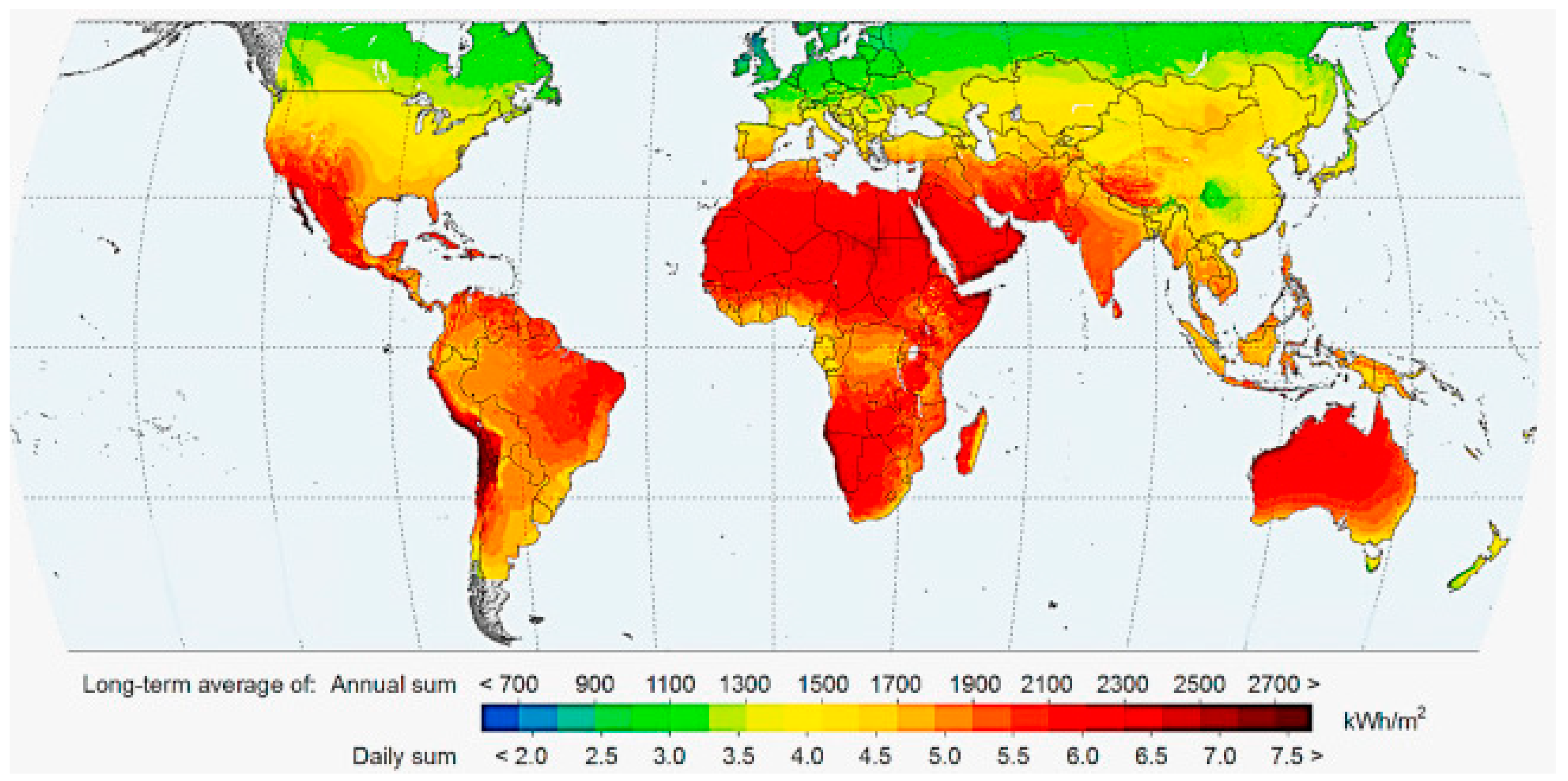
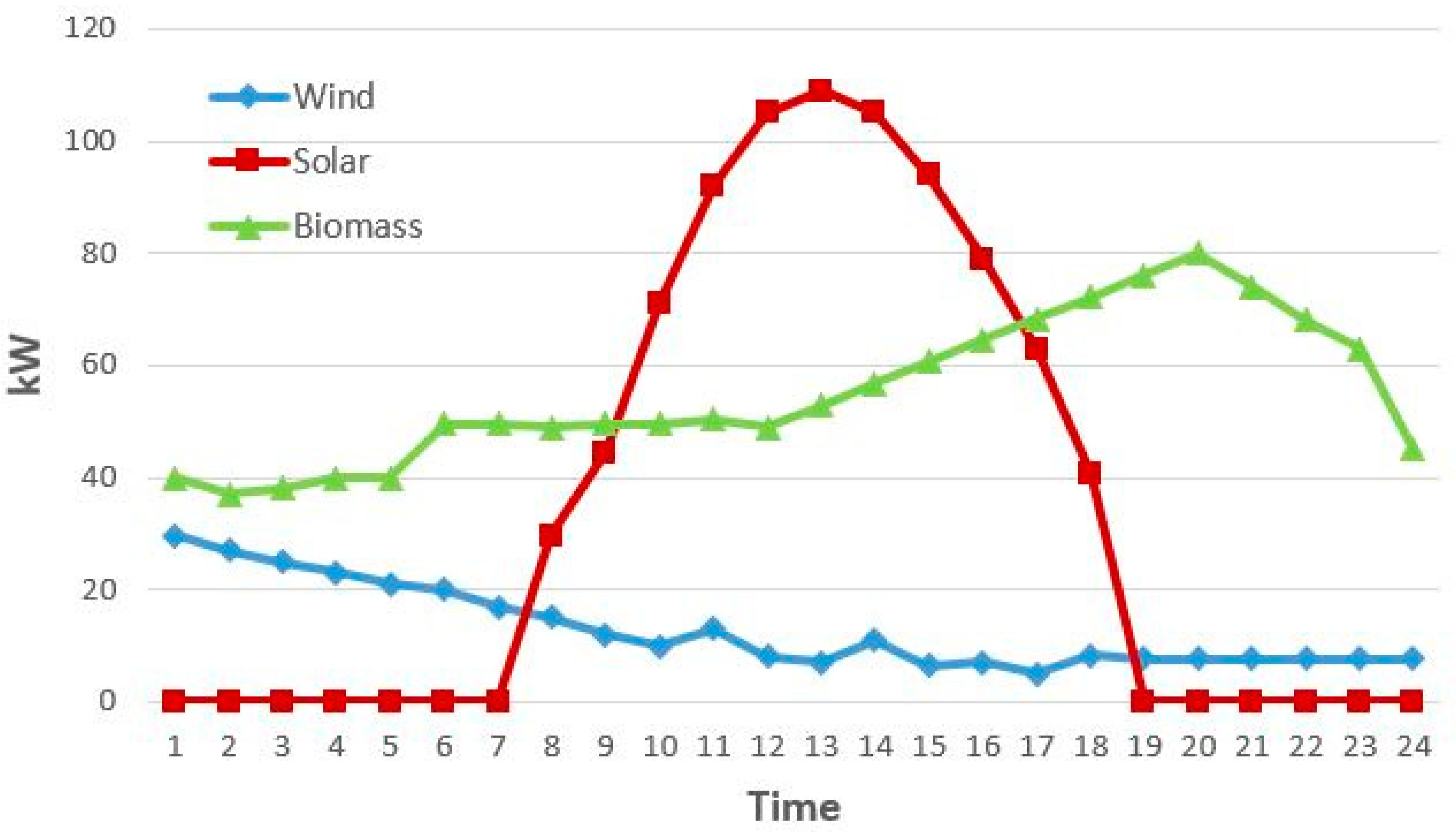
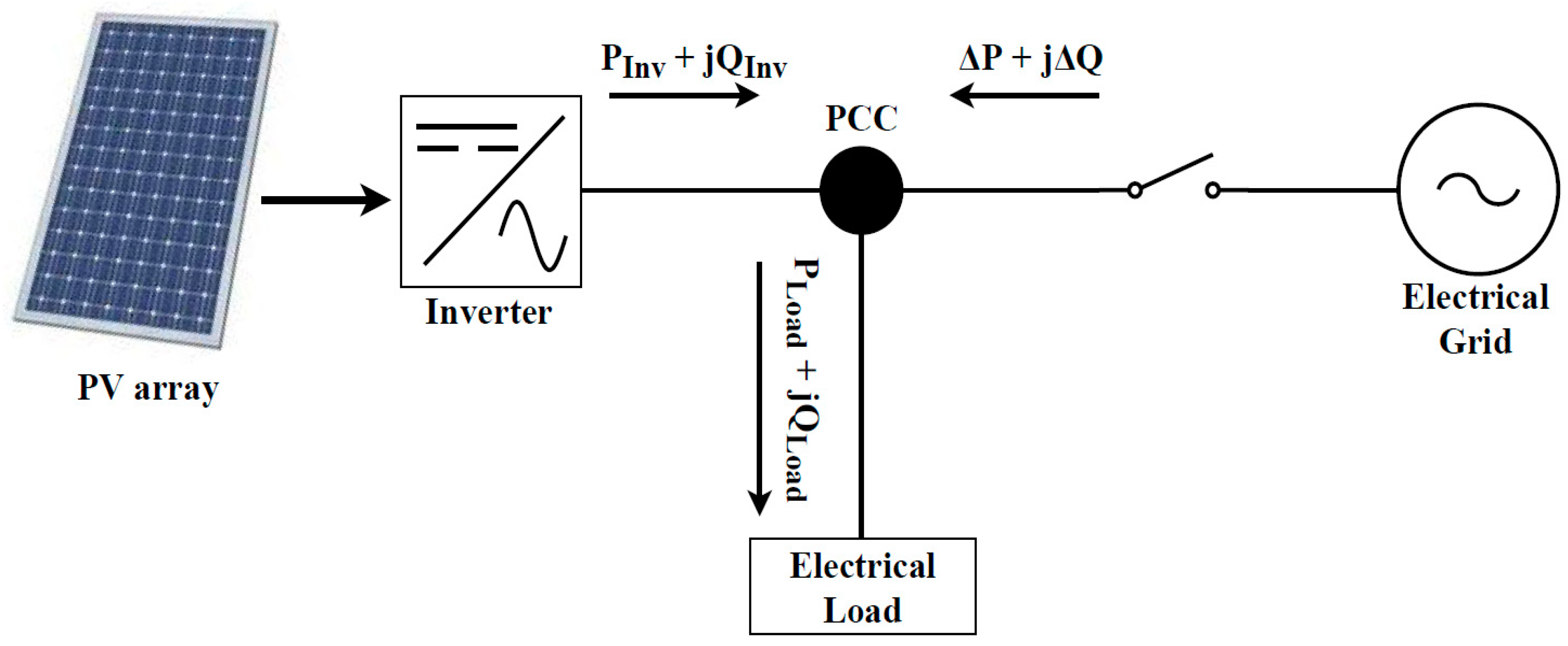
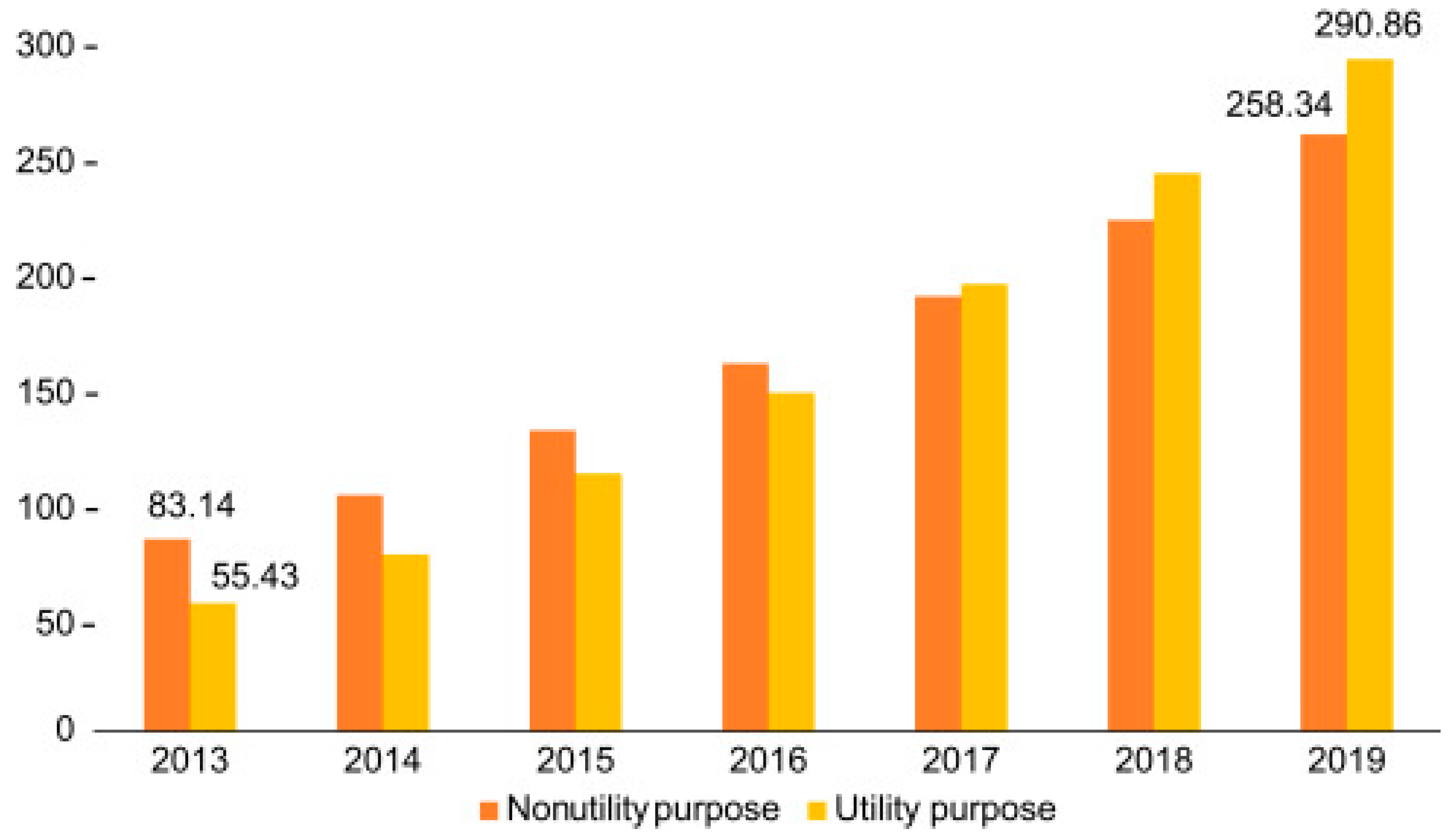
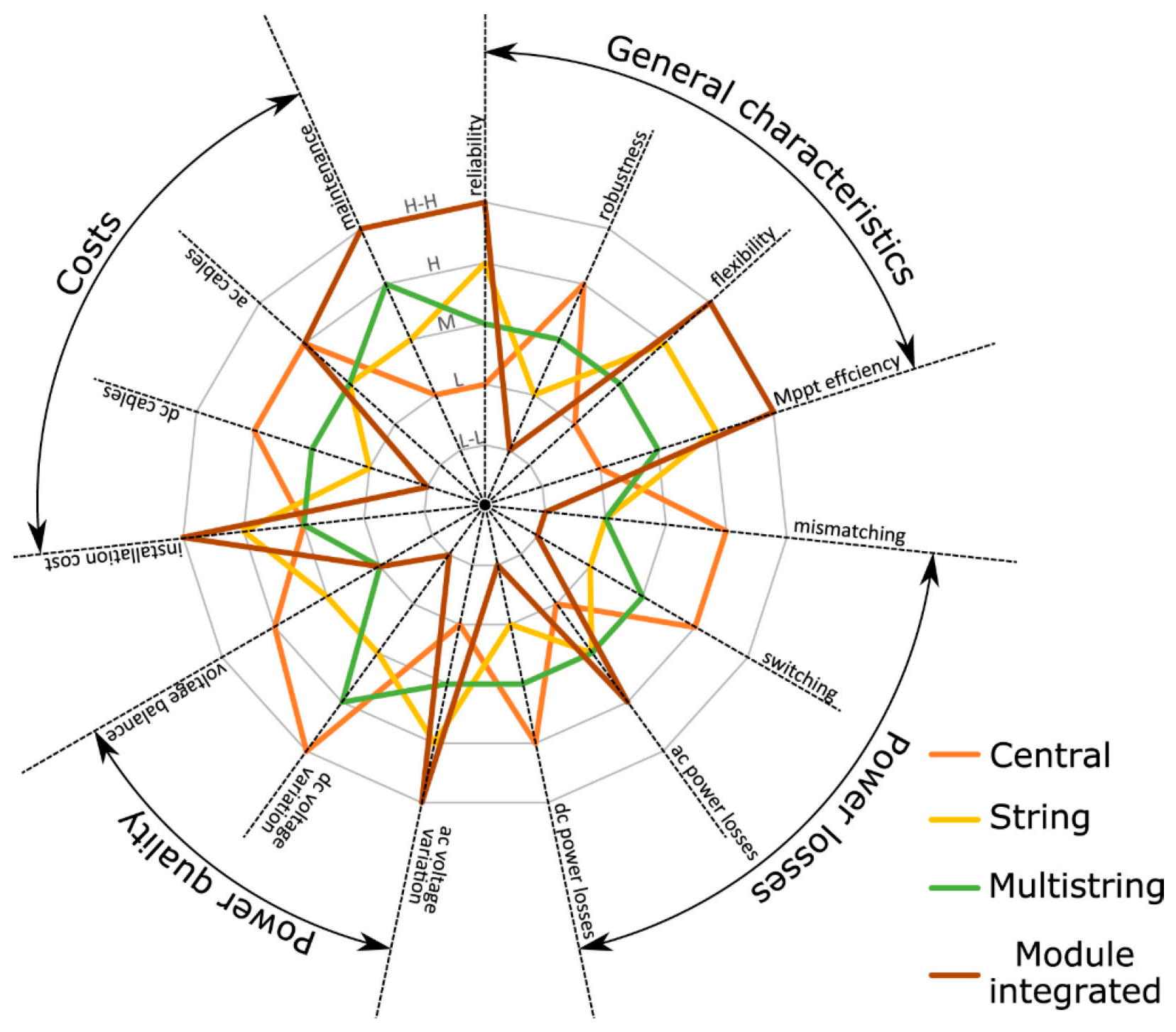

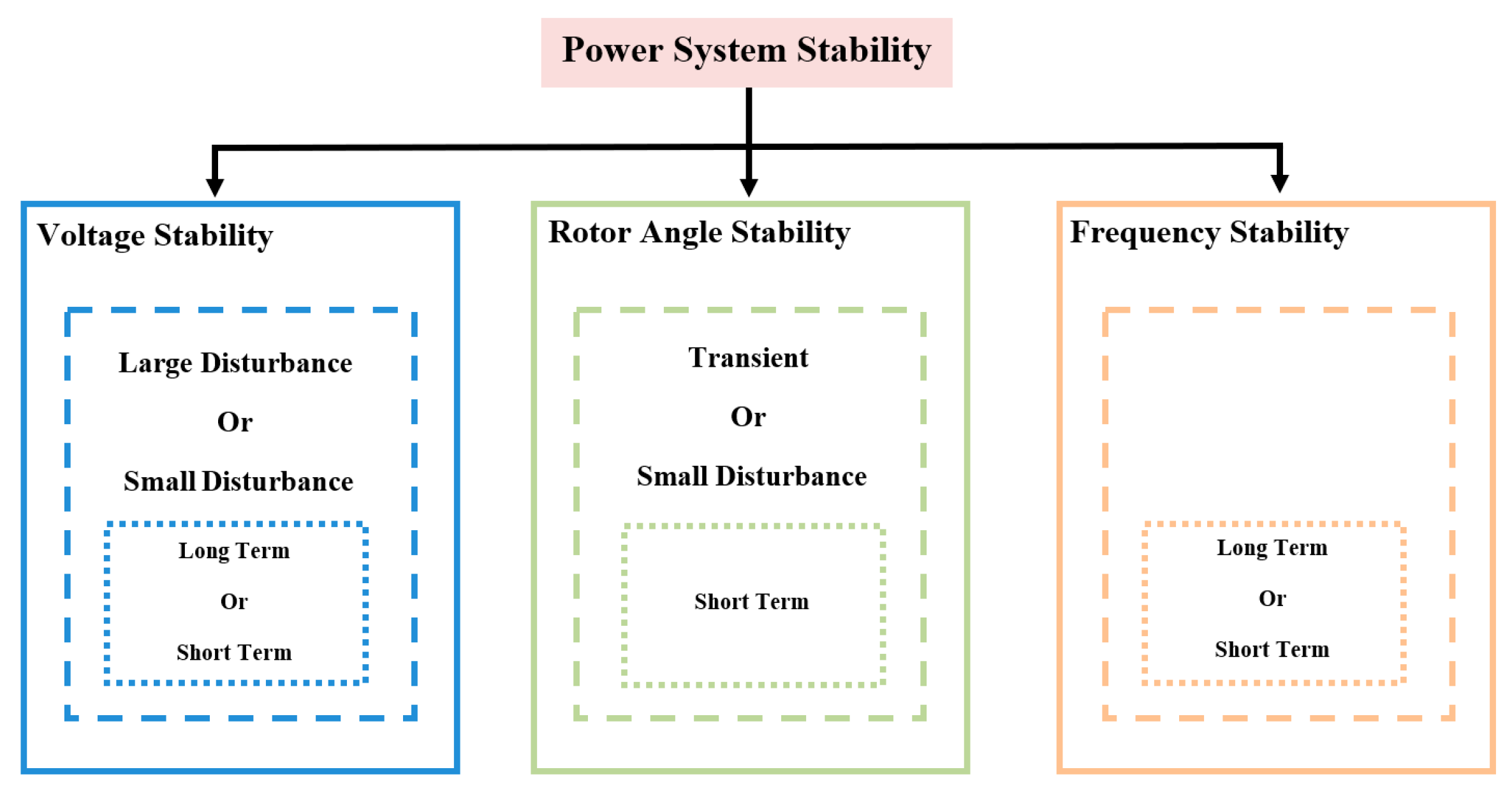

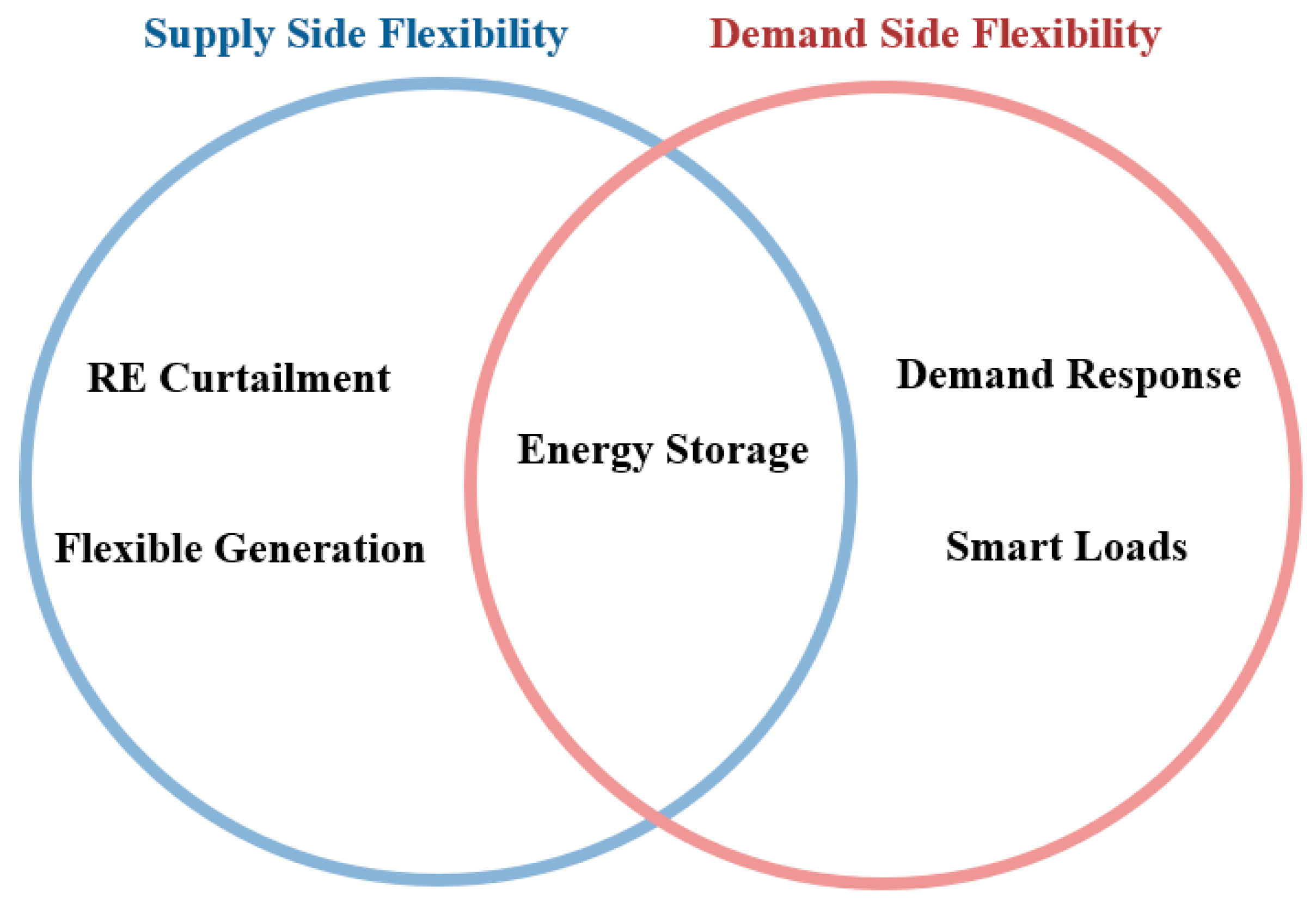
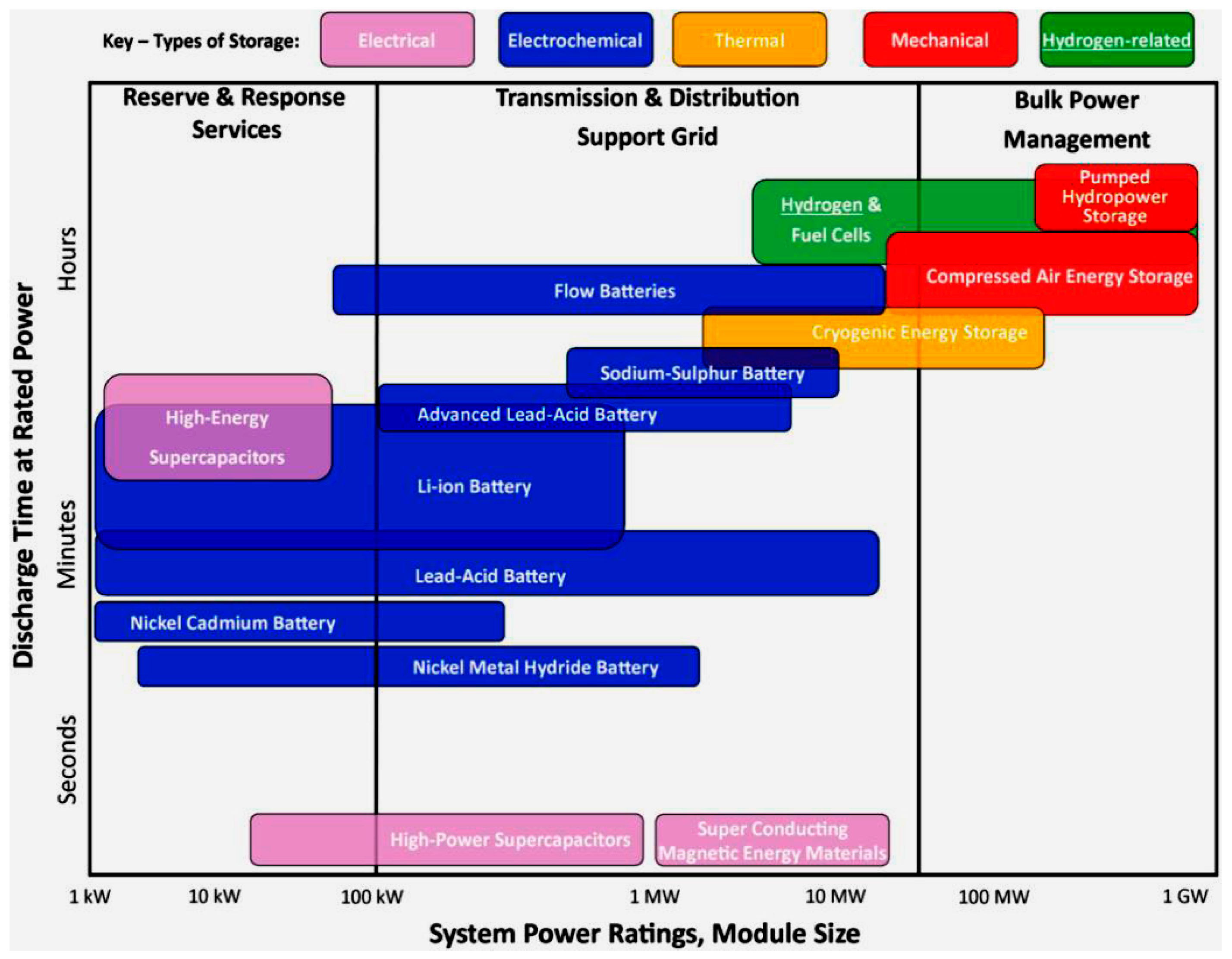
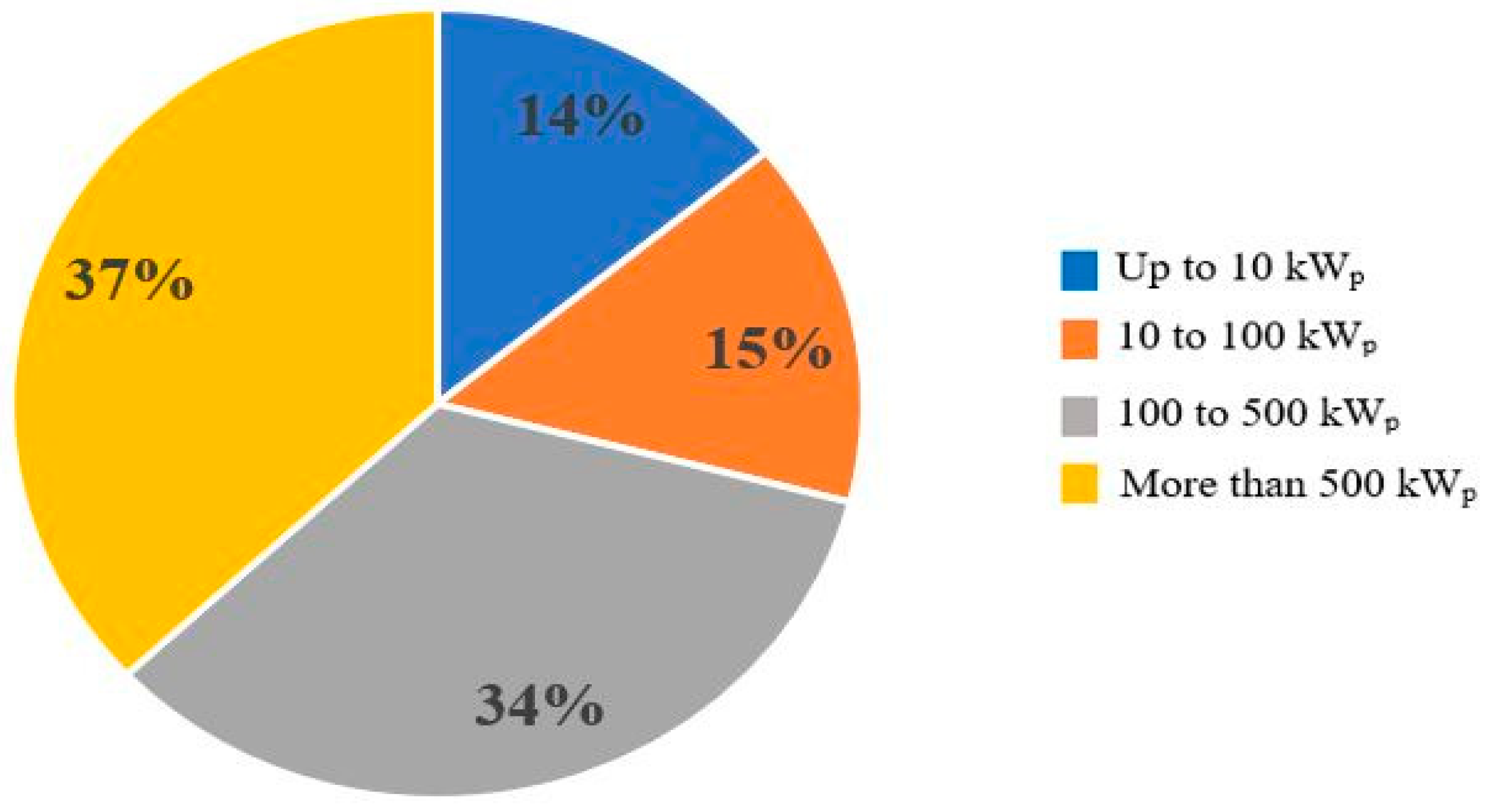
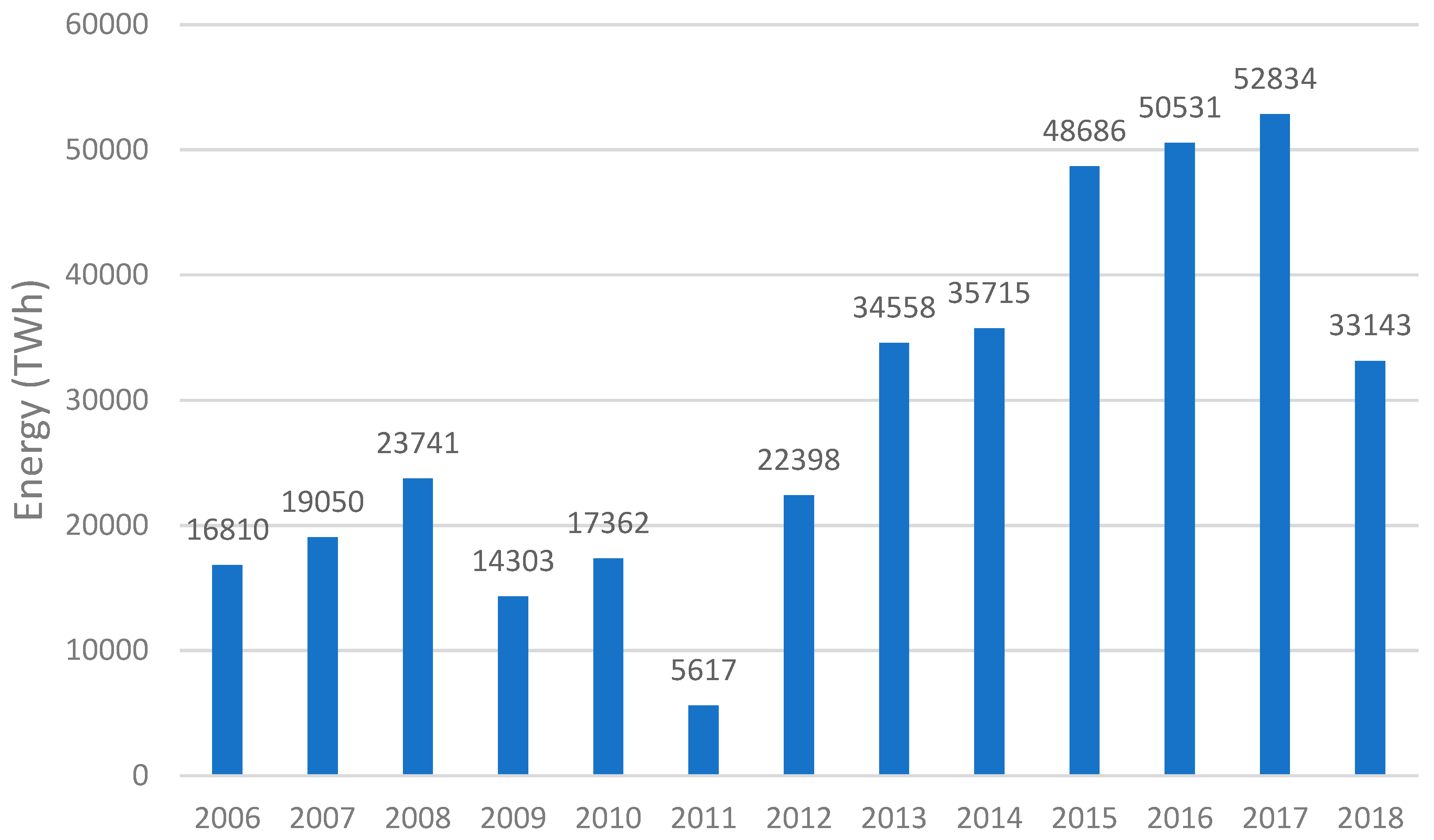
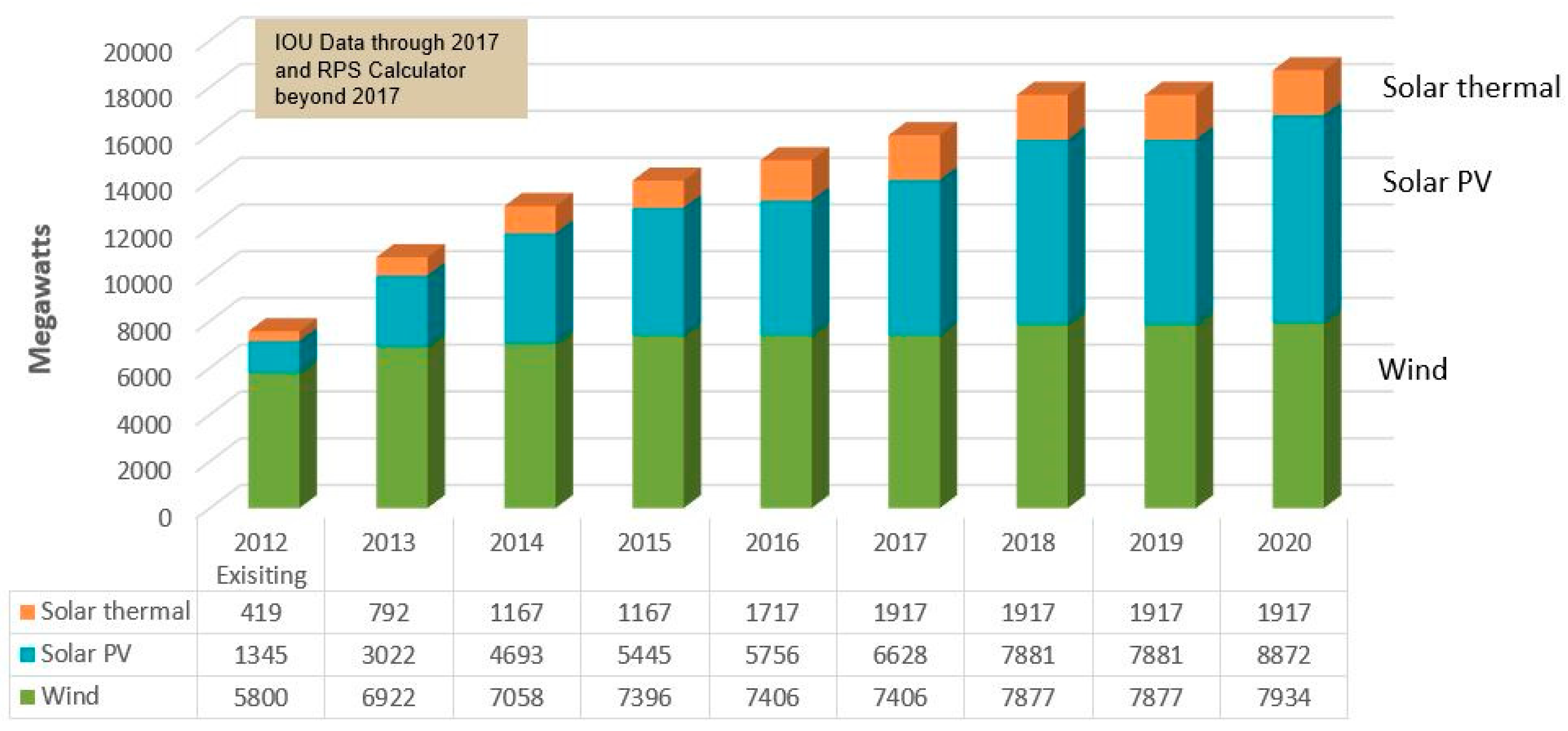
| Characteristics | Conventional Gas/Oil Combined Cycle Generators | Wind | PV |
|---|---|---|---|
| Capital cost (2018 $/kW) | 999 | 1624 | 1969 for tracking 1783 for fixed tilt |
| Variable O&M (2018 $/MWh) | 3.61 | 0 | 0 |
| Fixed O&M (2018 $/kW/year) | 11.33 | 48.42 | 22.46 |
| PV Plant Name | Location | Size (MW) | Commissioned Year |
|---|---|---|---|
| Yanchi Solar PV Station | China | 1000 | 2016 |
| Solar Star Projects | USA | 575 | 2015 |
| Desert Sunlight Solar Farm | USA | 550 | 2015 |
| Topaz Solar Farm | USA | 550 | 2011–2014 |
| Longyangxia Hydro-Solar PV Station | China | 480 | 2013–2015 |
| Copper Mountain III Solar Facility | USA | 350 | 2015 |
| Charanka Park PV power plant | India | 345 | 2012–2015 |
| ESS Technology | Configuration | Round Trip Efficiency | Life Time (Year) |
|---|---|---|---|
| Pumped Hydro | Conventional | 0.70–0.82 | 50–60 |
| Compressed Air | Underground | 0.70–0.89 | 20–40 |
| Aboveground | 0.70–0.90 | 20–40 | |
| Flywheel | High Speed | 0.93–0.95 | 15–20 |
| Battery | Lead-acid | 0.70–0.90 | 5–15 |
| Na-S | 0.75–0.90 | 10–15 | |
| ZEBRA | 0.86–0.88 | 15–15 | |
| Li-ion | 0.85–0.95 | 5–15 | |
| VRFB | 0.65–0.85 | 5–10 | |
| Zn-Br | 0.60–0.70 | 5–10 | |
| Fe-Cr | 0.72–0.75 | 10–15 | |
| Ni-Cd | 0.60–0.73 | 10–20 | |
| PSB | 0.65–0.85 | 10–15 | |
| Zn-air | 0.60–0.70 | 5–10 | |
| Supercapacitor | Double Layer | 0.85–0.95 | 10–20 |
| SMES | SMES | 0.95–0.98 | 15–20 |
| Hydrogen | Fuel Cell | 0.33–0.42 | 15–20 |
| Gas Turbine | 0.33–0.42 | 15–20 |
© 2019 by the authors. Licensee MDPI, Basel, Switzerland. This article is an open access article distributed under the terms and conditions of the Creative Commons Attribution (CC BY) license (http://creativecommons.org/licenses/by/4.0/).
Share and Cite
Alshahrani, A.; Omer, S.; Su, Y.; Mohamed, E.; Alotaibi, S. The Technical Challenges Facing the Integration of Small-Scale and Large-scale PV Systems into the Grid: A Critical Review. Electronics 2019, 8, 1443. https://doi.org/10.3390/electronics8121443
Alshahrani A, Omer S, Su Y, Mohamed E, Alotaibi S. The Technical Challenges Facing the Integration of Small-Scale and Large-scale PV Systems into the Grid: A Critical Review. Electronics. 2019; 8(12):1443. https://doi.org/10.3390/electronics8121443
Chicago/Turabian StyleAlshahrani, Abdullah, Siddig Omer, Yuehong Su, Elamin Mohamed, and Saleh Alotaibi. 2019. "The Technical Challenges Facing the Integration of Small-Scale and Large-scale PV Systems into the Grid: A Critical Review" Electronics 8, no. 12: 1443. https://doi.org/10.3390/electronics8121443
APA StyleAlshahrani, A., Omer, S., Su, Y., Mohamed, E., & Alotaibi, S. (2019). The Technical Challenges Facing the Integration of Small-Scale and Large-scale PV Systems into the Grid: A Critical Review. Electronics, 8(12), 1443. https://doi.org/10.3390/electronics8121443






